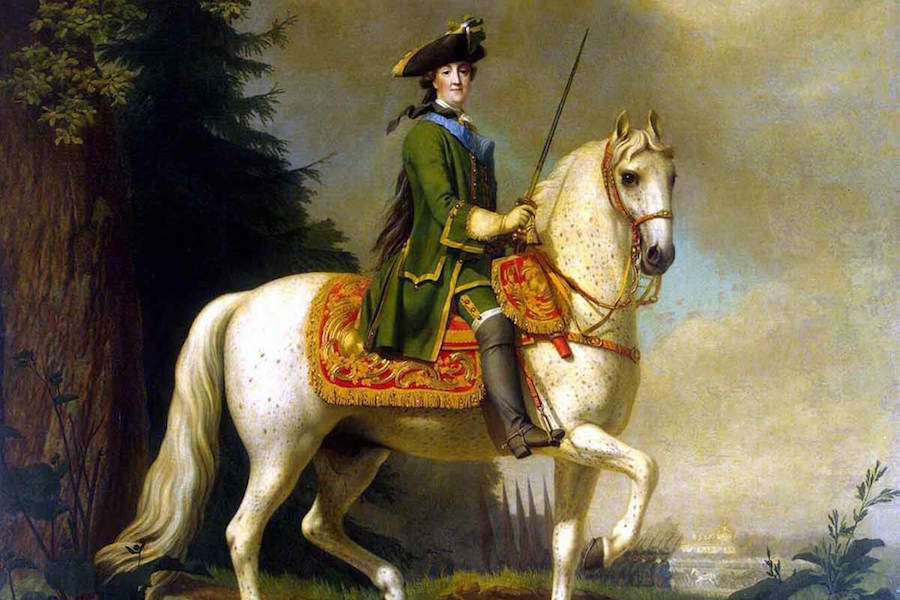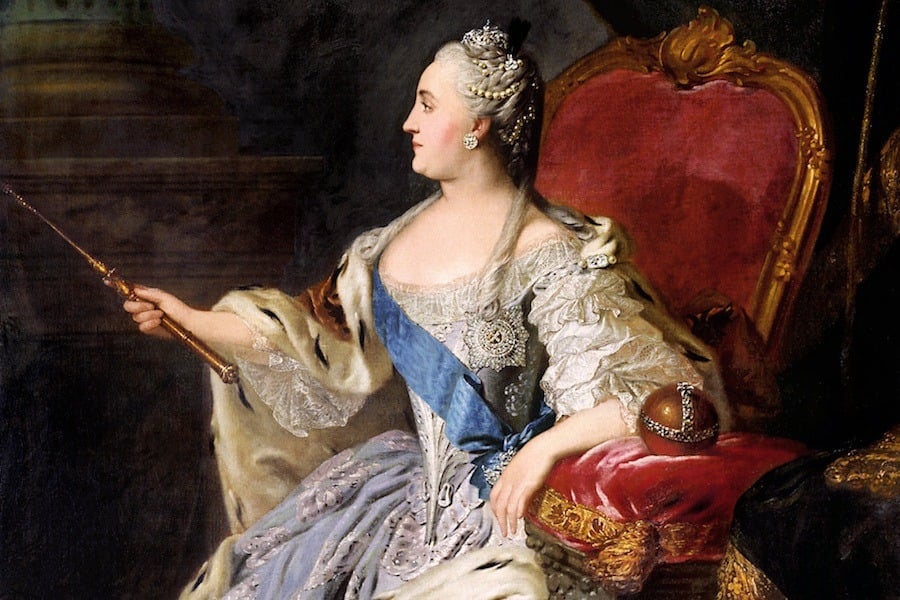![Catherine II FRokotov After Roslin 1770 Hermitage]()
Hermitage MuseumCatherine II of Russia (Catherine the Great), circa 1770.
For more than three decades in the late 18th century, one woman ruled with an iron fist over all of Russia. That woman was Catherine the Great, and the power she held as a woman led the press as well as world leaders to crucify her for it.
Thus while Catherine may have claimed victory in several wars, expanded Russia’s borders, and helped usher her country into a new age of art and culture, most of what we remember about her today are the misogynist rumors that her rivals used to slander her, especially one infamous story involving the empress and her horse. Below we provide a handful of those rumors — and debunk them:
Catherine The Great’s Infamous Death
![Catherine The Great Horse]()
Vigilius Eriksen/Grand Peterhof PalaceEquestrian portrait of Catherine the Great in uniform of the Preobrazhensky Regiment, one of the oldest Imperial Russian guard units, circa 1762.
The most widely known story of Catherine the Great involves her death at age 67 in 1796.
The rumor goes that Catherine — at that point already internationally “known” for a supposedly outsized sexual appetite (outsized compared to how men thought women should act) — perished when a harness holding a stallion positioned above her broke, causing the horse to fall and crush her. The innuendo was that she had been having sex with the horse.
The story, whose actual source is unclear, supposedly gained traction after Catherine’s servants reported that the empress would hide away in the stables with her Arabian stallions for long hours, without supervision. On a deeper level, the story likely took its cues from foreign fears about Russia’s growing power in Europe (more on that later).
Other nonsensical rumors suggested that Catherine had died when her toilet seat broke underneath her, or even that she’d died because assassins had hidden spring-loaded blades in her toilet seat that activated when she sat down.
In reality, however, Catherine was writing a letter the last time she was seen alive. Sometime later, she suffered a stroke (reportedly while actually on the toilet). Servants eventually found her collapsed in the washroom, but it was too late by this point. She passed away while doctors cared for her in bed.
Foreign Slander
Click here to view slideshow
England and France, especially via their political cartoons (some of which you can view above), drove much of the Catherine the Great rumor-mongering.
French cartoonists and broadsheet writers in particular consistently denigrated Catherine, in ways that often involved her supposed promiscuity, after she came out against the French Revolution.
In fact, the story of Catherine and the horse directly stems from her position against the revolution. At the time, European monarchs used equestrian portraits as a way to emphasize their royal power and prestige. France, however, was in the midst of a revolution that fought against both that kind of power and all aristocratic and monarchistic pretensions. Thus, the idea of describing Catherine as having sex with a horse was the French way of satirizing her royal power -- and dredging up her alleged sexual voracity.
The English, on the other hand, largely attacked Catherine for her political power grabs.
In the decades before her death, Catherine had led Russia to war several times against the Ottoman Empire, and had come away successful, allowing her to colonize new territory in Europe. This expansion made the English -- then the world's great colonial superpower -- nervous.
In fact, the Triple Alliance of 1788 between England and what is now Germany and the Netherlands formed specifically to counter Catherine's efforts to expand Russia's sphere of influence in Europe.
However, Catherine fired back by sowing dissent within Great Britain. With a clever use of back channels and propaganda, she turned the English parliament against their own and politically destroyed the country's main proponent of anti-Russian sentiment, Prime Minister William Pitt the Younger.
Thus the Triple Alliance fell apart before it could ever go to war against Russia, sparing Catherine's army from the combined might of English and German military action.
Entrenched Misogyny
![Catherine Great Wand]()
Fyodor Rokotov/Tretyakov GalleryEmpress Catherine The Great, circa 1763.
Frederick the Great -- ruler of Russia's neighbor and geopolitical rival, Prussia -- had some strongly misogynistic feelings toward Catherine the Great.
As he wrote to his brother 12 years after Catherine took the throne from Peter III:
"A woman is always a woman and, in feminine government, the cunt has more influence than a firm policy guided by straight reason."
Sexism aside, Frederick disliked Catherine because of her governing style in which she would send trusted advisers to remote parts of the country to handle things in her stead, rather than relying on official bureaucratic channels.
This represented a return to the old way of Russian governing. And as far as Frederick was concerned, this move kept power centralized, and made Russia more impregnable to outside influence, thus making the country a bigger threat.
It also didn't help that one of Catherine's trusted advisers, Grigory Potemkin, was her lover, who she allowed to handle matters of state, such as making a peace deal with the Ottomans.
The fact that Catherine and Potemkin were lovers allowed Frederick and his court to create and spread rumors about Catherine's inappropriate sexual habits as a way of attacking and mocking her position as a ruler simply because she was a woman.
And in this case, Frederick's dislike of women happened to align with Prussian state interests against Russia, and he thus fueled the fires of misogyny and allowed them to burn within his country unchecked, and unfairly damaging Catherine's reputation in the process.
Sex And Power
![Coup Copy]()
Wikimedia CommonsCatherine The Great on a balcony at the Winter Palace on June 28, 1762, the day of the coup where she wrestled power away from Peter III, the husband who despised her.
While men like Frederick the Great certainly invented misogynistic rumors involving Catherine's sexual habits in order to damage her reputation, a few small truths do tether those rumors to reality. It is true that Catherine used sex as a tool to secure and broaden her political power.
First and foremost, she elevated her main lovers into powerful positions because she could trust them. She did this because she couldn't trust the country's systemic bureaucracy, filled with noblemen who had no love for her and who had been installed by her predecessor, late husband, and ultimately political enemy, Peter III, in order to bring European-style government to Russia.
Instead, Catherine went back to the old Russian way of governing an empire with borders on opposite ends of the world: trusted advisers acting in her stead. For example, she placed Stanisław August Poniatowski, an ex-lover, on Poland's throne simply in order to know that she fully controlled Russia's eastern neighbor.
Moreover, Catherine trusted two of her lovers, Grigory Orlov and Grigory Potemkin, with the most influence. Orlov -- with the aid of his brothers -- helped Catherine usurp the Russian throne from Peter III, killing him in the process, in 1762, while Potemkin would later become her secret husband.
Potemkin was by far Catherine's most longstanding and favored lover. She showered him with more titles, responsibilities, and money than anyone else, and even built the Tauride Palace, one of the largest palaces in Saint Petersburg, specifically for him. She crowned him Prince of the Russian Empire, had him create entire cities from scratch, and made him commander of all Russian forces during the 1787 war with Turkey.
It's safe to say that, in Catherine's day, few other women in the world exercised that much power over men -- and few other women were slandered so greatly for it.
Intrigued by this look at Catherine the Great? Next, see how vodka has shaped the course of Russian history, before reading up on some of history's most powerful women.
The post How Catherine The Great Shook Up Europe’s Male Power Structure — And Was Punished For It appeared first on All That Is Interesting.

























